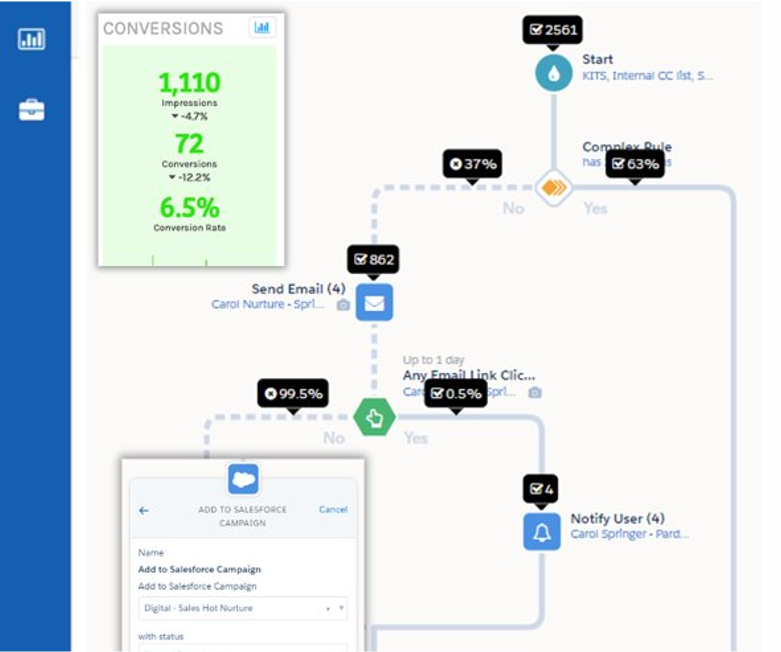
How to Create a Lead Nurturing Workflow

Creating a Lead Nurturing Workflow
Creating an awesome lead nurturing workflow involves careful planning, personalized content, and continuous optimization. By having a deeper understanding of your customer, you are better positioned to identify their specific needs, or pain points. By providing helpful and personalized content at each point in sales cycle, you earn the opportunity to engage a sales lead and nurture them further into the funnel towards that delightful moment when they become a customer.
Only a very small percentage of potential customers who seek out information about your product or service are ready to buy when they start their sales journey. The others need to be educated and listened to, and their wants need to be assessed at various points once they enter the sales funnel. Just like any other relationship, they need to be nurtured from interested party in order to convert to valued client.
Lead nurturing at its simplest means taking an interested party and building that relationship so that someone who was not ready to buy at the beginning of their sales journey becomes someone ready to pull the trigger and become a satisfied customer.
Define Your Goals: Clearly outline your objectives for the lead nurturing workflow. Identify your target audience segments based on their interests, behaviors, and stage in the buyer’s journey. You’ll need to consider how each customer is different, and work to find commonalities among both existing customers and potential ones. Demographics are one powerful segmentation tool; gender, company position, age, income level and geographical location are all attributes that you can take into account as you create content. Certain industries gravitate to approaches driven by SMS or social media, while others rely on more traditional email communication. Statistics derived from those emails are already likely a crucial part of how you track leads; similarly, the ways in which your potential customers interact with your website should be a key in determining what kind of content you provide them with as you lead them through your funnel.
Once you know your goals and outcomes, start building a lead nurturing workflow with these key considerations.
- Understand Your Buyer’s Journey: Map out the stages of your buyer’s journey and the content needs at each stage. Tailor your lead nurturing content to align with the needs of leads as they progress through the funnel.
- Segment Your Leads: Segment your leads based on their demographics, interests, past interactions, and behavior. This will enable you to deliver personalized content that resonates with each segment.
- Create Valuable and Relevant Content: Develop high-quality content that educates, informs, and addresses the pain points of your leads. Offer a mix of content types, such as blog posts, e-books, webinars, case studies, and videos.
- Automate Your Workflow: Utilize a marketing automation platform to set up the lead nurturing workflow. Automate the delivery of content and trigger actions based on lead behavior or engagement.
- Start with a Welcome Email: The first email in your workflow should be a warm and engaging welcome message. Thank the lead for their interest and set expectations for future communications.
- Personalize Your Content: Use the data you have collected to personalize your emails and content for each lead segment. Address leads by their names and tailor the content to their specific interests.
- Use Behavioral Triggers: Set up behavioral triggers to send specific content based on lead actions, such as website visits, content downloads, or email clicks.
- Progressive Profiling: Gradually collect additional information from leads over time using progressive profiling. Use the data to further personalize your interactions.
- Include Calls-to-Action (CTAs): Encourage engagement and further interactions with your content by including relevant CTAs that direct leads to the next stage in the buyer’s journey.
- Lead Scoring and Grading: Implement lead scoring and grading to identify highly engaged and qualified leads. Prioritize your follow-up efforts based on lead scores.
- Test and Optimize: Continuously test different elements of your lead nurturing workflow, such as subject lines, content, and send times. Analyze the results and make data-driven improvements.
- Align Marketing and Sales: Foster collaboration between your marketing and sales teams. Share insights and feedback to ensure a seamless transition of leads from marketing to sales.
- Measure and Track Results: Monitor the performance of your lead nurturing workflow using key metrics such as open rates, click-through rates, conversion rates, and lead-to-customer conversion.
- Iterate and Improve: Based on the data and insights, make necessary adjustments and improvements to your lead nurturing workflow to enhance its effectiveness continually.
Remember that an effective lead nurturing workflow is customer-centric, personalized, and focuses on building trust and relationships with your leads. By providing valuable content, addressing their needs, and engaging with them at the right time, you can guide leads through the buyer’s journey and increase the likelihood of converting them into loyal customers.









